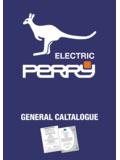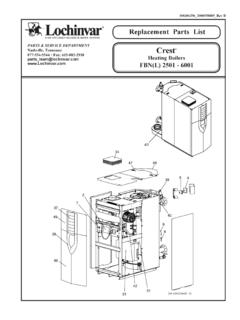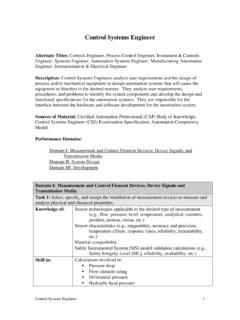Transcription of Pneumatic Building Controls Overview and DDC …
1 Millennial Net, Inc. 285 Billerica Road, Chelmsford, MA 01824 USA Tel: +1 978 569 1925 1 Pneumatic Building Controls Overview and Conversion to Direct Digital Controls (DDC) Pneumatic Building Controls How Does It Work A Pneumatic control system uses compressed air as a medium of control for HVAC systems. Compressed air is carried via copper and plastic tubes from a controller to a control device, usually a damper or valve actuator. This control method relies on sensors and thermostats that bleed or retain the line pressure from the sensor to the control device and the actuator. Each senor responds to changes in temperature, humidity, and static pressure as examples, to provide feedback in a control loop to open or close the actuator to meet the control set point.
2 The actuators contain diaphragms and spring to function in sequence with the control signal. This system uses the compressed air as the communication method. Each thermostat in a Building with a Pneumatic control system has one or more air lines connected to it from the main source of compressed air and to some type of final device such as a valve. Hardware Some of the air actuated local controllers in a Pneumatic system include: Sequencing Cumulator, Air Gauges, control Valves, Isolation Valves, Solenoid Valves, and Pressure-Electric (PE) Switches. Pneumatic control systems have limited remote monitoring capabilities. They can include calibrated gauges that can indicate space and control conditions such as temperature and pressure.
3 All Pneumatic systems rely on bi-metallic metals and leak ports to operate effectively to changing space conditions. This system requires very clean dry air as a source and all controllers and thermostats need to be continually maintained because over time they will drift out of calibration. Difference Between Electrical Based DDC and Pneumatic Systems Pneumatic Building Controls Systems utilize compressed air to communicate commands from controllers to the equipment instead of an electric or electronic control signal for controlling the Building . Unlike electrical based DDC systems, there is no electrical control or power wires connected to a thermostat or from the thermostat to the VAV boxes.
4 The amount of air pressure in the control line will dictate the action and level of position for a valve or damper. In some conditions, that air pressure can command a two position Pneumatic /electric (on/off) switch to carry the Pneumatic signal to operate an electric device such as a fan. These airlines will also be connected to certain air actuated valves at VAV boxes and Dampers to turn on and off heating coils, fans, etc. Therefore a pneumatically controlled Building will have air lines through a Building (supply air) which are connected back to a central point (air compressor and dryer) and each the various thermostats. From each thermostat addition air lines (Branch line) will be installed that connect the thermostat with a local control device (VAV).
5 To reiterate, there is no electricity powering the thermostats nor are there any electrical control wires. Millennial Net, Inc. 285 Billerica Road, Chelmsford, MA 01824 USA Tel: +1 978 569 1925 2 Converting Pneumatic Building to a DDC System Major Considerations It is an involved process because in a DDC system is electric/electronic based both in powering the system components and the communication method. Where ever a thermostat is required, communication and control wiring and in some cases an addition power circuit either a control voltage such as 24 volts or line voltage of 120 volts must be installed. Adding this power source may require the installation of a control transformer to convert 120 volts to 24 volts.
6 Each thermostat will have communication wiring installed from the thermostat to the VAV boxes and/or roof top units at a bare minimum. In the case of a DDC system, communication wiring must also be installed back to the central controller or system. To convert an existing Pneumatic control system to a DDC system, there are two base options regarding the existing systems: 1. Leave the Pneumatic actuators in place, or 2. Replace them with electric/electronic actuators. In any Pneumatic to DDC conversion, any sensing device for temperature, humidity, pressure, etc., must be replaced with a new sensor designed to communicate with the new DDC controllers. Pneumatic valves and dampers work effectively and can operate in harsh environments, which means they can be reused and you save the labor & material costs associated with replacing them.
7 If the end control devices are left in place such as the valve actuators, then electronic to Pneumatic transducers our required to maintain control . In a VAV application, the VAV boxes (assuming these are not replaced) will need a new control module for the heating coils, dampers, and fans. There will also be the requirement to replace the temperature and air flow sensors for each box. Other Concerns On-going replacement/repair equipment is also a consideration during a review of a Pneumatic conversation. Pneumatic Controls installations can go back over a hundred years, many of the devices are no longer available and have to be cross-referenced to other current manufactures. In the case of a Pneumatic to DDC conversion, many people also recommend removing the air lines during the installation of the wiring.
8 This can be a very costly task and not normally required unless the control tubes are used a method to pull in the new communications and power lines. For more information on the Millennial Net Wireless DDC Pneumatic thermostat Wi-Stat IIIp see Contact: Millennial Net, Inc. 285 Billerica Road Chelmsford, MA 01834 USA Tel: +1 978-569-1925 Fax: +1 978-256-3162




